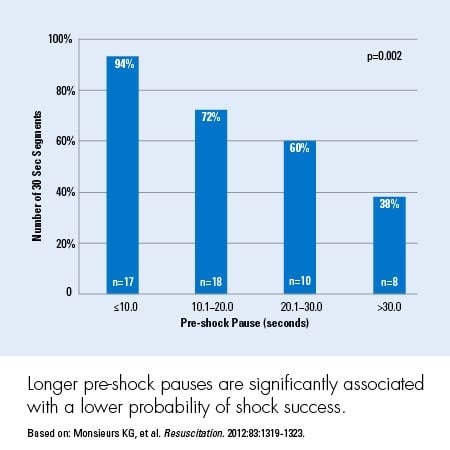During Cpr Chest Compression Fraction Should Be at Least
A benefit of in-hospital cardiac arrest is the opportunity for rapid initiation of high-quality chest compressions as defined by current American Heart Association AHA adult guidelines as a depth 224 inches full chest recoil rate 100120 per minute and minimal interruptions with a chest compression fraction CCF 60. The goal for the percent of the time for performing chest compressions is recommended for at least 60 during CPRThis percent of the time is known as the chest compression fraction timeChest compression fraction is a measurement of the proportion of total resuscitation time that compressions are performed.

The Impact Of Increased Chest Compression Fraction On Survival For Out Of Hospital Cardiac Arrest Patients With A Non Shockable Initial Rhythm Resuscitation
This percent of the time is known as the chest compression fraction time.

. Samdeck4383 Samdeck4383 1 week ago Medicine College answered During cpr chest compression fraction should be at least. Minimizing pauses during high-quality CPR. The 2020 International Consensus guidelines recommend the use of a feedback device for cardiopulmonary resuscitation CPR training to facilitate effective CPR based on the evaluation of its components including compression depth compression rate chest wall recoil and interruption time 26.
Its critical to note that in a hospital setting the consensus is that compression fraction should be. In adult and child cardiac arrest it may be reasonable to perform CPR with a chest compression fraction of at least 60. Click here to get an answer to your question During cpr chest compression fraction should be at least.
Chest compression fraction is a measurement of the proportion of total resuscitation time that compressions are performed. For an infant use 2 fingers placing them at the sternum slightly below the chest and between the nipples. Chest compression fraction is a measurement of the proportion of total resuscitation time that compressions are performed.
Check for a pulse precharge the defibrillator and be prepared to deliver a shock in 10 seconds or less. Carry out Rescue Breaths. The new rate of chest compressions is 100 to 120 compressions or pushes per minute compared to at least 100 in previous guidelines according to the American Heart Association.
High-quality CPR performance metrics include. During CPR chest compression fraction CCF should be at least and ideally greater than. The AHAs 2013 CPR Consensus Statement called for a compression fraction of at least 80 percent.
0 to 20 21 to 40 41 to 60 61 to 80 and 81 to 100. Press down fast and hard around one-third depth of the chest at a rate of 100 times per minute. 1 See answer Samdeck4383 is waiting for your help.
This means performing at least 100 per minute and avoiding pauses in between each compression to allow for full chest wall recoil after every few seconds of pushing down on it with either hand. Carry out about 30 compressions which are about 15 inches deep. This percent of the time is known as the chest compression fraction time.
You can only achieve high chest compression fraction CCF by. 15 seconds before pausing compressions at the end of each 2--minute cycle high-performance teams should. The goal for the percent of the time for performing chest compressions is recommended for at least 60 during CPR.
The goal for the percent of the time for performing chest compressions is recommended for at least 60 during CPR. We categorized chest compression fraction from 0 to 100 into 5 groups based on the average chest compression fraction delivered to the patient over all minutes with available data. Summary results are presented as mean SD or median interquartile range.
Chest Compression Fraction Greater Than 80 For adequate tissue oxygenation it is essential that healthcare providers minimize interruptions in chest compressions and therefore maximize the amount of time chest compressions generate. It is reasonable to pause compressions for 10 seconds 60 to deliver 2 breaths. A team of EMTs and paramedics are attempting to resuscitate a man who is in cardiac arrest while his wife and son are present.
For adolescents and adults a rescuer should push down at least 2 inches but no more than 24 inches on the chest compared to at least 2 inches in previous guidelines. True or False The optimal target for the chest compression fraction should be at least 50. Chest compression fraction 80 Compression rate of 100-120min Compression depth of at least 50 mm 2 inches in adults and at least 13 the AP dimension of the chest in infants and children No excessive ventilation.
Add your answer and earn points. The 2015 Guidelines lowered that figure to at least 60 percent. You should be compressions-focused when delivering CPR.
Chest compression fraction is a measurement of the proportion of total resuscitation time that compressions are performed. The goal for the percent of the time for performing chest compressions is recommended for at least 60 during CPRThis percent of the time is known as the chest compression fraction timeChest compression fraction is a measurement of the proportion of total resuscitation time that compressions are performed. High-performing EMS systems target at least 60 10 seconds with 80 5 seconds or higher being a frequent goal.
You should attempt to maintain a chest compression fraction of at least.

High Performance Cpr Prehospital Guide To Improving Resuscitation Ppt Download

Utilizing Feedback To Improve Cpr Performance Ppt Download

Abstract 32 Chest Compression Fraction Increased When Police Used Aed That Analyses Heart Rhythm During Cpr Circulation

No comments for "During Cpr Chest Compression Fraction Should Be at Least"
Post a Comment